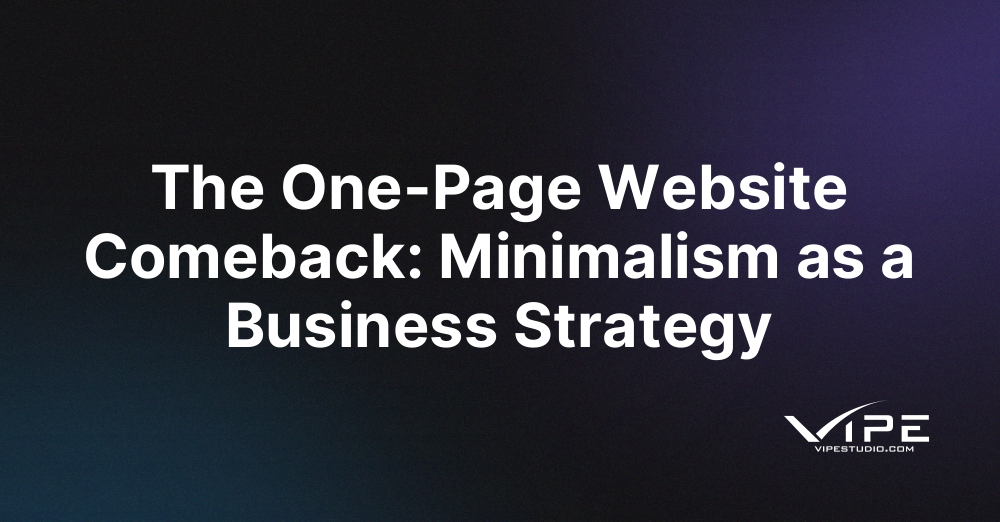13.11.2025
WordPress Development
The One-Page Website Comeback: Minimalism as a Business Strategy
READING TIME: MIN
Table of Content
Introduction: The Resurgence of One-Page Websites
For years, one-page websites were considered simplistic and outdated. Yet in the modern digital landscape, they are experiencing a comeback. Driven by mobile-first design, faster load times, and clarity of messaging, one-page websites offer a compelling strategy for businesses seeking impact without complexity. WordPress provides the flexibility to implement minimalist designs that still deliver functionality, performance, and engagement.
Why Minimalism Works
Minimalism is not merely aesthetic-it is strategic. By focusing on essential content, businesses can guide visitors through a curated narrative, reducing cognitive load and increasing conversion potential. This design philosophy emphasizes:
- Clear messaging and hierarchy
- Faster page load times
- Ease of maintenance and updates
- Strong visual focus on calls to action
Businesses adopting minimalist strategies often consult experts using a WordPress agency to ensure functionality is maintained without clutter.
Designing the One-Page Experience
The core challenge of a one-page site is content organization. Sections must flow logically, allowing visitors to consume information progressively. Anchors, smooth scrolling, and responsive layouts create a seamless experience. WordPress offers themes and builders, such as Elementor and Oxygen, that facilitate full-page layouts while maintaining accessibility standards.
Content Hierarchy and Storytelling
Every section should serve a clear purpose. Companies often structure one-page websites around:
- Hero and value proposition
- Features or services
- Portfolio or case studies
- Testimonials or social proof
- Contact or call to action
Storytelling becomes vital. Each scroll should reinforce the brand’s identity and guide users to a desired outcome. Well-crafted content ensures that minimalism does not equate to emptiness.
Performance and SEO Considerations
One-page websites can excel in performance if executed correctly. Minimizing scripts, optimizing images, and leveraging caching improve load times. From an SEO perspective, the challenge lies in ranking for multiple topics with a single URL. WordPress plugins like Yoast and Rank Math, combined with strategic content structuring, allow one-page sites to perform well in search engines.
Interactive Elements and Engagement
Minimalist design does not mean static pages. Interactive elements, including sliders, animations, and scroll-triggered effects, increase engagement. WordPress allows developers to implement these interactions while maintaining speed and accessibility. The balance between aesthetics and functionality is critical; too many effects can negate minimalism and slow down performance.
Conversions in One-Page Layouts
The ultimate goal is often conversion-contact form submissions, newsletter sign-ups, or purchases. Minimalism reduces distractions and focuses attention on calls to action. Techniques include:
- Sticky navigation bars for persistent access
- Clear, concise CTAs placed strategically
- Progressive disclosure of information to maintain interest
Some organizations turn to experts for support, arranging a Vipe Studio WordPress inquiry to ensure conversion paths are optimized without compromising design simplicity.
Responsive Design and Mobile Optimization
One-page websites excel in mobile-first environments. Scroll-based navigation aligns naturally with mobile interactions, reducing bounce rates. WordPress themes often include responsive frameworks, but developers must ensure touch targets, font sizes, and content flow remain optimal across devices.
Challenges of One-Page Websites
Despite benefits, one-page websites have limitations. Complex businesses with extensive offerings may struggle to convey all information. Overcrowding a single page can reduce clarity, defeating minimalism’s purpose. Maintenance of interactive features and SEO targeting requires ongoing attention, especially as content and strategies evolve.
Case Studies: One-Page Success Stories
Several startups and agencies have embraced one-page websites with notable success. For example, product launches often rely on a single-page narrative to guide visitors from introduction to purchase. Creative portfolios showcase projects without navigating away from the page. Non-profits leverage one-page storytelling to focus on mission-driven content, donations, and volunteer engagement.
Best Practices for WordPress Implementation
To achieve an effective one-page website:
- Use modular page builders to organize sections
- Optimize all media for fast loading
- Ensure semantic HTML and accessibility compliance
- Integrate analytics to measure engagement
- Maintain simplicity in navigation and messaging
Developers often test staging environments and gather user feedback before launch, ensuring design decisions align with usability goals.
Conclusion: Minimalism as Strategic Advantage
One-page websites demonstrate that simplicity can drive both clarity and performance. By prioritizing essential content, optimizing for speed, and maintaining user engagement, businesses can achieve a strong online presence without overwhelming visitors. WordPress provides the flexibility to execute these designs effectively, making minimalism not a limitation but a strategic advantage.
Key Takeaways
- One-page websites prioritize essential content and clarity of messaging.
- Minimalism improves performance, mobile experience, and user focus.
- Storytelling, interactive elements, and CTAs drive engagement and conversions.
- WordPress provides themes and tools to implement responsive, minimalist designs.
- SEO and analytics must be adapted for single-page structures.
- Expert consultation can optimize both design and functional outcomes.
More on The Topic
- Staging Sites That Reveal Organizational Blind Spots
- WordPress Performance Debt Nobody Talks About
- The Admin UX That Shapes Decisions
- Scaling WordPress Without Losing Culture
- WordPress 6.9 “Gene”: What This Release Really Changes
The content of this website is copyrighted and protected by Creative Commons 4.0.



